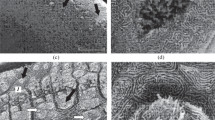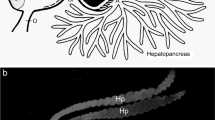Synopsis
The wide variety of aquatic food is considered to be instrumental for the diversification in fish species. Yet their abilities and inabilities of handling food are poorly known. For these reasons the food processing and feeding repertoire of the adult carp, Cyprinus carpio, fed on a variety of food types, were analyzed by light and X-ray cinematography of the head parts and by electromyography of the head and body muscles during feeding. Nine stereotyped movement patterns (particulate intake, gulping, rinsing, spitting, selective retention of food, transport, crushing, grinding and deglutition) compose the feeding process, their sequence and frequency were adjusted to the type of food. Following quantitative morphological analysis at macroscopic, light- and electronmicroscopical level, the relations between the functioning and architecture of the feeding apparatus were established. The structure and dimensions of the mouth opening, the protrusible upper jaw, the slit-shaped pharyngeal cavity, the palatal and postlingual organ, the branchial sieve, the pharyngeal masticatory apparatus and the distribution of taste buds, mucous cells and muscle fibers along the oropharyngeal surface were the directive structural characters used for estimating the abilities in food processing. The specializations for utilizing food items and its limitations, derived from structural and functional data, are compared with diet data found in the literature in order to evaluate the relative position of the carp in competition for food in the aquatic environment. It is established that the ‘omnivorous’ carp is specialized in effective handling of several categories of aquatic food, even when these are mixed with non-food (bottom invertebrates <4% SL in diameter) since the palatal organ enables the carp to separate food from non-food. This includes very hard-skinned food items, processed with the powerful pharyngeal jaws of the fish, and to a lesser extent zooplankton (>250 μm). The carp is at the same time very limited in processing long and struggling prey (e.g. fish) as well as vegetable matter, due to the lack of oral teeth and the specialized morphology of its pharyngeal chewing apparatus. These feeding abilities agree with diet data from literature. The reported herbivorism of carp illustrates its opportunism in feeding behaviour. Specialization in feeding is discussed and the necessity to take into account the total series of post-capture feeding actions for a more complete view on trophic specialization. Food intake and the intra-oral food processing of carp are bound to the structures of its sensory, central processing and effector apparatus and to the plasticity in their functioning. These together determine its feeding efficiency in exploiting the available aquatic food resources. Next to ethological and ecological studies functional morphology is another important tool to explain the trophic interactions of fish.
Similar content being viewed by others
References cited
Alexander, R.McN. 1969. Mechanics of the feeding action of a cyprinid fish. J. Zool. 159: 1–15.
Barel, C.D.N. 1983. Towards a constructional morphology of cichlid fishes. Neth. J. Zool. 33: 357–424.
Colman, J.A. & P. Edwards. 1987. Feeding pathways and environmental constraints in waste-fed aquaculture: balance and optimization. In: R.S.V. Pullin & D.J.W. Moriarty (ed.) Detrital Systems for Aquaculture. Int. Center for Living Aquatic Resources Management, Manila (in press).
Cummins, K.W. & J.C. Wuycheck. 1971. Caloric equivalent for investigations in ecological energetics. Mitt. Int. Ver. Limnol. 18: 1–158.
Darnell, R.M. 1964. Organic detritus in relation to secondary production in aquatic communities. Verh. Int. Ver. Limnol. 15: 462–470.
Drost, M.R. & J.G.M. van den Boogaart. 1986. The energetics of feeding strikes in larval carp (Cyprinus carpio). J. Fish Biol. 29: 371–379.
Fanget, R. 1972. Contribution à l'écologie des étangs piscicoles de la Dombes: sur le regime alimentaire de la carpe à miroir (Cyprinus carpio L.). Doctoral Thesis, University of Lyon, Lyon. 62 pp.
Fischer, Z. 1968. Food selection in grass carp (Ctenopharyngodon idella Val.) under experimental conditions. Polskie Arch. Hydrobiol. 15: 1–8.
Janssen, J. 1976. Feeding modes and prey size selection in the alewife (Alosa pseudoharengus). J. Fish Res. Board Can. 33: 1972–1975.
Lammens, E.H.R.R. 1985. A test of a model for planktivorous filter feeding by bream Abramis brama. Env. Biol. Fish 13: 288–296.
Lammens, E.H.R.R., H.W. de Nie, J. Vijverberg & W.L.T. van Densen. 1985. Resource partitioning and niche shifts of bream (Abramis brama) and eel (Anguilla anguilla) mediated by predation of smelt (Osmerus eperlanus) on Daphnia hyalina. Can. J. Fish. Aquat. Sci. 42: 1342–1351.
Lammens, E.H.R.R., J. Geursen & P.J. McGillavry. 1986. Diet shifts, feeding efficiency and coexistence bream (Abrimis brama), roach (Rutilus rutilus) and white bream (Blicca bjoerkna) in hypertrophic lakes. pp. 50–64. In: Interactions Between Fishes and the Structure of Fish Communities in Dutch Shallow Eutrophic Lakes. Doctoral Thesis, University of Wageningen, The Netherlands. 100 pp.
Lauder, G.V. 1980. The suction feeding mechanism in sunfishes (Lepomis): an experimental analysis. J. exp. Biol. 88: 49–72.
Leeuwen, J.L. van & M. Muller. 1984. Optimum sucking techniques for predatory fish. Trans. Zool. Soc. London 37: 137–169.
Liem, K.F. 1978. Modulatory multiplicity in the functional repertoire of the feeding mechanism in cichlid fishes. J. Morph. 158: 323–360.
Liem, K.F. 1980. Adaptive significance of intra- and interspecific differences in the feeding repertoires of cichlid fishes. Amer. Zool. 20: 295–314.
Liem, K.F. 1984. Functional versatility, speciation and niche overlap: are fishes different? pp. 269–305. In: D.G. Meyers & J.R. Strickler (ed.) Trophic Interactions Within Aquatic Ecosystems Amer. Ass. Adv. Science, Washington, D.C.
Magnan, P. & G.J. Fitzgerald. 1984. Mechanisms responsible for the niche shift of brook charr, Salvelinus fontinalis Mitchill, when living sympatrically with creek chub, Semotilus atromaculatus Mitchill. Can. J. Zool. 62: 1548–1555.
Moriarty, D.J.W. 1973. The physiology of digestion of bluegreen algae in the cichlid fish Tilapia nilotica. J. Zool. 171: 25–40.
Morita, Y. & T.E. Finger. 1985. Topographic and laminar organization of the vagal gustatory system in the goldfish (Carassius auratus). J. Comp. Neur. 238: 187–201.
Moss, B. 1980. Ecology of freshwaters. Blackwell Scientific Publications, London. 332 pp.
Muller, M. & J.W.M. Osse. 1984. Hydrodynamics of suction feeding in fish. Trans. Zool. Soc. London 37: 51–135.
Nelson, J.S. 1976. Fishes of the world. John Wiley and Sons, New York. 416 pp.
Nikolsky, G.V. 1963. The ecology of fishes. Academic Press, London. 352 pp.
Osse, J.W.M. 1969. Functional morphology of the head of the perch (Perca fluviatilis L.): an electromyographic study. Neth. J. Zool. 19: 289–392.
Osse, J.W.M. 1985. Jaw protrusion, an optimization of the feeding apparatus of teleosts? Acta Bioth. 34: 219–232.
Prowse, G.A. 1961. The use of fertilizers in fish culture. Proc. Indo-Pacif. Fish. Coun. 9: 73–75.
Schäperclaus, W. 1962. Traité de pisciculture en étang. Vigot, Paris. 620 pp.
Sibbing, F.A. 1976. Pharyngeal mastication in Cyprinus carpio (L.). Rev. Trav. Inst. Peches Marit. 40: 744–745.
Sibbing, F.A. 1982. Pharyngeal mastication and food transport in the carp (Cyprinus carpio L.): a cineradiographic and electromyographic study. J. Morph. 172: 223–258.
Sibbing, F.A. 1986. The role of taste in the feeding mechanism of the carp (Cyprinidae). Chem. Sens. 11: 661–662.
Sibbing, F.A. & R. Uribe. 1985. Regional specializations of the oropharyngeal wall and food processing in the carp (Cyprinus carpio L.). Neth. J. Zool. 35: 377–422.
Sibbing, F.A., J.W.M. Osse & A. Terlouw. 1986. Food handling in the carp (Cyprinus carpio L.), its movement patterns, mechanisms and limitations. J. Zool. London (A) 210: 161–203.
Steffens, W. 1980. Der Karpfen. Ziemsen Verlag, Wittenberg Lutherstadt, 215 pp.
Stein, R.A., J.F. Kitchell & B. Knezević. 1975. Selective predation by carp (Cyprinus carpio L.) on benthic mollusks in Skadar Lake, Yugoslavia. J. Fish Biol. 7: 391–399.
Uribe-Zamora, M. 1975. Selection des proies par le filtre branchial de la carpe miroir (Cyprinus carpio L.). Doctoral Thesis, University of Lyon, Lyon. 127 pp.
Werner, E.E. & D.J. Hall. 1974. Optimal foraging and the size selection of prey by the bluegill sunfish (Lepomis macrochirus). Ecology 55: 1042–1052.
Werner, E.E. & D.J. Hall. 1976. Niche shifts in sunfishes: experimental evidence and significance. Science 191: 404–406.
Werner, E.E. & G.G. Mittelbach. 1981. Optimal foraging: field tests of diet choice and habitat switching. Amer. Zool. 21: 813–829.
Wheeler, A. 1978. Key to the fishes of Northern Europe. Frederic Warne Publ., London. 380 pp.
Wright, D.I., W.J. O'Brien & C. Luecke. 1983. A new estimate of zooplankton retention by gill rakers and its ecological significance. Trans. Amer. Fish. Soc. 112: 638–646.
Wunder, W. 1936. Physiologie der Süsswasserfische Mitteleuropas. 340 pp. In: R. Dernoll & H.N. Maier (ed.) Handb. der Binnenfischerei Mitteleuropas Bd. 2B, Stuttgart.
Zaret, T.M. 1980. Predation and freshwater communities. Yale University Press, London. 187 pp.
Author information
Authors and Affiliations
Rights and permissions
About this article
Cite this article
Sibbing, F.A. Specializations and limitations in the utilization of food resources by the carp, Cyprinus carpio: a study of oral food processing. Environ Biol Fish 22, 161–178 (1988). https://doi.org/10.1007/BF00005379
Received:
Accepted:
Issue Date:
DOI: https://doi.org/10.1007/BF00005379




